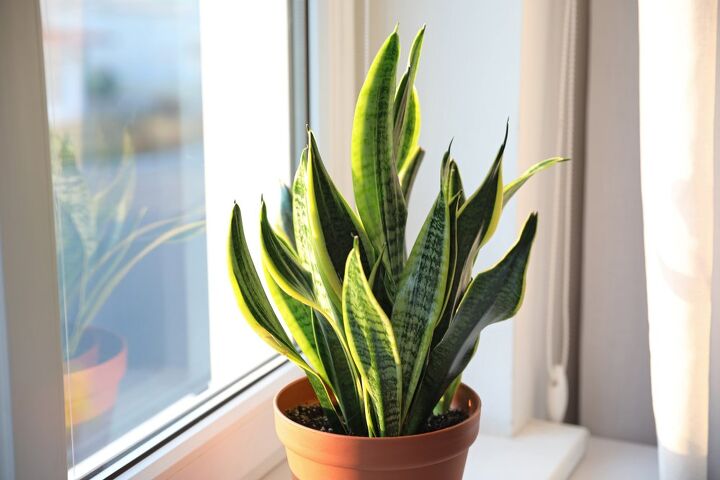Can Snake Plants Live Outside?

Snake plants are a type of succulent, which makes them rather easygoing and low maintenance, especially when compared to other plants. This makes them a great choice for people who like plants but don’t necessarily have a green thumb.
Furthermore, they are an aesthetically pleasing plant that can add to any room throughout your home or outside around your property, too. Even though they are hard to kill, there are some things to consider to keep them in good condition.
That being said, snake plants can grow and live outdoors either in pots or directly in the soil, depending on where you live. They do need warmer temperatures to survive and certain levels of light to thrive on their own, so it is important to pay attention to the weather conditions on a daily basis if you are planning to grow your snake plants outside.
Before you consider moving your snake plant outdoors, read on to learn about how it behaves throughout different seasons as well as its differences when growing outside versus inside.
Do You Need Landscaping Services?
Get free, zero-commitment quotes from pro contractors near you.

Growing Snake Plants Outdoors
It’s true that snake plants are very easygoing, but they can run into more issues when they are planted outdoors. This is because it’s much harder to control conditions than it would be if the plant was growing in a room inside your home. Here are some things to keep an eye on when it comes to keeping your snake plants outside.
Direct Sunlight
Snake plants thrive in bright levels of light and can survive under direct sunlight, too. That said, it’s still best not to leave them in direct sunlight for long periods of time. This is because the light can begin to burn the leaves. Typically, you should try to leave your snake plant in indirect sunlight for at least five hours for best results throughout the day.
Misting Leaves on Hot Days
Snake plant leaves already contain water, so they can self-hydrate even on very dry days. When you add mist the leaves, the only thing you’ll be doing is creating the risk for fungal development. Even when watering your plant, you should avoid getting water on the leaves. The roots in the soil are what will need the water.
Cold Temperatures
Snake plants need warm temperatures to survive, so it’s unwise to keep them outside without a place to keep them warm. This can mean potting them indoors during the winter or installing a greenhouse for storage.
Pests
Though snake plants are naturally pest-resistant, they can easily be exposed to infestations when growing outside. This is because the plants that are around it will attract pests that will eventually go to the snake plant, too.
Be sure to check on them periodically to ensure your snake plant is pest-free. If an issue has already occurred, you may need to debug the plant, especially if you’re moving them indoors.
Moving Indoor Snake Plants Outdoors
If your snake plant has spent its life indoors, it’s going to need an adjustment period before it can live healthily outside long-term. For starters, place your snake plant outside in partial shade for about a week, so it can get used to the conditions.
From there, you can slowly expose it to more and more light until it is completely used to being outside. Just be sure to keep them in comfortable conditions throughout the year regardless of what is going on outside. This may involve moving the plant back inside when the weather gets too bad.
Snake Plants in the Summer
Snake plants are well-suited for the heat, so most summer days should not pose a real problem to its overall health. Typically, you won’t have to worry about damaging them in temperatures up to 90 degrees Fahrenheit.
However, temperatures higher than that can damage the leaves of the plant by burning them. If you live in a region with really hot summers, you will want to take special care to move your plant into a cooler area on exceptionally hot days. That means you’ll want to leave them potted instead of planting them directly into the ground outside.
Snake Plants in the Winter
Much like high heat, cold temperatures can also negatively impact your snake plant. For this reason, you should pot your snake plants if you live in an area that experiences cold winters, too. Generally speaking, you should not leave snake plants in temperatures below 50 degrees Fahrenheit for extended periods of time.
Winter will also bring along changes in humidity, so you need to take care to maintain humidity levels. Consider using a humidifier to keep the conditions around your snake plant as consistent as possible.
Watering Snake Plants
These types of plants can naturally grow in dry conditions, so they can survive weeks without water. In fact, one of the biggest problems many people run into with their snake plants is overwatering them.
There are a couple of ways to gauge when to give your snake plants more water. For starters, the tips of the plant may begin to get brown. Even if the plant itself looks fine, it still may be time to water it. Simply poke your finger an inch into the soil to see if it is still damp or if it has dried out.
As we mentioned above, be sure to target the soil when it is time to water the plant. The leaves already have enough water inside them and watering them will only cause potential fungus growth.
Evasive Snake Plant Roots
Snake plants aren’t extremely invasive, but they can be when planted outdoors. This is particularly true in warmer climates. Fortunately, there are some things you can do to avoid the growth of these roots, so you can still successfully have your snake plant outside without ruining the rest of your garden.
Related Questions
How big do snake plants get?
Typically, snake plants can grow between eight and 15 feet high, and the leaves are usually between one and two feet long. They will usually grow higher when placed outdoors because they have more consistent exposure to natural light throughout the day and will have more space to grow, too.
Can you make snake plants grow faster?
Already, they are one of the fastest-growing plants and tend to grow about four to 12 inches each year. Snake plants need light to photosynthesize, which makes them grow more quickly. Another way to make your snake plant grow faster is to re-pot it, so the roots are still crowded together but do not get too cramped.
How can you avoid over-fertilizing your snake plant?
Usually, you will only have to feed snake plants with well-balanced and very diluted substances. Too much fertilization can actually stunt the growth of the plant over time. The best way to avoid this problem is to fertilize during the spring and summer, reduce to half the amount during the fall, and don’t fertilize at all in the winter.
Do You Need Landscaping Services?
Get free, zero-commitment quotes from pro contractors near you.

Final Thoughts on Growing Snake Plants Outdoors
Snake plants are durable plants that can survive many different conditions. That said, cold temperatures are not ideal for their health. This is important to consider if you decide to grow your snake plants outdoors.
You will also need to think about how much light it’s getting and protecting it from insects and pests. Other than that, there’s not much more you need to do. Overall, your snake plant should be fine outside during the spring, summer, fall, and warmer winter days.

I am a copywriter and editor based in the Las Vegas area with nearly a decade of experience under my belt writing landing pages, cost guides, blog posts, newsletters, case studies, and social media content. I have a degree in Strategic Communication and experience working in both the account and creative spheres. My goal is to always be discovering new interests and bettering myself as a writer and editor along the way.
More by Kerry Souder


























![How To Reset A Whirlpool Cabrio Washer [In 5 Easy Steps!]](https://cdn-fastly.upgradedhome.com/media/2023/07/31/9076531/how-to-reset-a-whirlpool-cabrio-washer-in-5-easy-steps.jpg?size=350x220)
